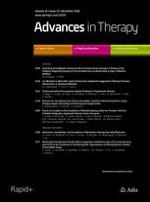Erschienen in:

22.10.2016 | Original Research
Multicenter Randomized Double-Blind Comparison of Nebivolol plus HCTZ and Irbesartan plus HCTZ in the Treatment of Isolated Systolic Hypertension in Elderly Patients: Results of the NEHIS Study
verfasst von:
Guido Grassi, Gino Seravalle, Gianmaria Brambilla, Raffaella Dell’Oro, Fosca Quarti Trevano, Francesco Fici, Luc van Bortel, Giuseppe Mancia
Erschienen in:
Advances in Therapy
|
Ausgabe 12/2016
Einloggen, um Zugang zu erhalten
Abstract
Introduction
The present study was aimed at comparing the antihypertensive efficacy, tolerability, and side effects profile of nebivolol/hydrochlorothiazide (NH) vs irbesartan/hydrochlorothiazide (IH) combination in elderly patients with isolated systolic hypertension (ISH).
Methods
124 ISH patients aged 69.1 ± 5.1 years (mean ± SD) were enrolled by 13 general practitioners in Netherlands and Belgium and randomized in a double-blind fashion to receive either NH (5/12.5 mg day, n = 62) or IH (150/12.5 mg day, n = 62) for a 12-week period. The primary efficacy endpoint of the study was the comparison of the two combinations in terms of sitting office systolic blood pressure (BP) reduction after 12 weeks of treatment. In addition ambulatory BP, 24-h BP variability, tolerability, and safety profile were also investigated.
Results
122 patients were included in the intention-to-treat analysis. After 12 weeks of treatment the reduction of systolic BP with NH was significantly greater than IH (−25.8 ± 12 vs −21.2 ± 14 mm Hg, P < 0.03). Diastolic BP reduction was significantly greater with NH after 4 and 8 weeks of treatment but similar at the end of the study (or after 12 weeks). In contrast, the magnitude of the 24-h, daytime, and nighttime systolic and diastolic BP reduction was almost similar in the two groups, while heart rate reduction induced by NH was significantly (P < 0.001) greater during the 24-h, daytime, and nighttime period than that induced by IH. NH caused a reduction in 24-h BP variability significantly greater than IH (standard deviation −4.4 ± 2.7 vs −2.2 ± 5.1 mm Hg, P < 0.02, variation coefficient −2.0 ± 2.6 vs −0.3 ± 3.4%, P < 0.01). Both treatment regimens were well tolerated.
Conclusions
These data provide evidence that NH reduces office BP more than IH but has similar effects on 24-h BP. NH reduces 24-h systolic and diastolic BP variability more than IH, suggesting a greater protective effect on a variable known to adversely affect prognosis.
Trial Registration
EU clinical Trials Register identifier, 2010-023104-28.
Funding
Menarini International Operations Luxembourg.











